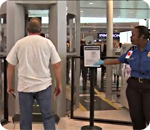
Lack of studies, questionable safety of full body airport x-rays continue to raise alarm
Sunday, August 19, 2012 by: J. D. Heyes
Tags: airport scanners, X-rays, health risk
- Newly released JFK files reveal Pentagon's role in creating Lyme disease and covid in the same lab
- Dr. Suzanne Humphries makes bombshell appearance on Joe Rogan podcast, exposing vaccine industry deception back to POLIOMYELITIS
- L.A.'s rebuilding nightmare: Only 4 permits issued after fire destroys 6,000 homes
- Discovery of vast underground city beneath Giza pyramids challenges human history
- Black cumin seed oil emerges as a powerful ally against breast cancer and chronic inflammation
- Catastrophic 7.7 earthquake devastates Myanmar and Thailand; death toll could reach 100,000
- AI breakthrough slashes celiac disease diagnosis time from months to minutes
- The hidden battle in your glass: How A1 and A2 milk could shape your health
- Sugar-free deception: Artificial sweeteners hijack hunger signals, fuel obesity epidemic, study warns
- Europe braces for WAR as EU urges citizens to STOCKPILE FOOD, in latest provocations with Russia
- Thomas Massie’s Dual Loyalty Disclosure Act aims to restore American sovereignty by cracking down on foreign influence in Congress
- Putin vows to 'finish off' Ukraine, accuses West of prolonging the war
- Aluminum pollution: A silent threat to human health
- Tesla owners under siege: Road rage, vandalism and political backlash fuel fear among drivers nationwide
- Kiss Your Genetic Privacy Good-Bye! 23andMe Gets Green Light to Sell Your Intimate Genetic Details to Anyone They Want
- Chaos in Amsterdam: Five injured in broad daylight knife attack near Dam Square
- "Feel G.O.O.D. Gut Health Program" on BrightU: Dr. Basima Williams introduces the Feel-Good Plate Method
- Trump's 25% auto tariffs: A bold move to strengthen U.S. manufacturing despite short-term challenges
- Newly released JFK files reveal Pentagon's role in creating Lyme disease and covid in the same lab
- Analysis: The coming economic collapse, a mass uprising and Trump's three secret weapons to halt the growing revolt
- Trump nominates VACCINE ZEALOT Susan Monarez to lead the CDC, sidelining RFK Jr.'s reform efforts
- Trump's greatest betrayal so far: Accelerating Middle East wars, silencing dissent, and serving Zionist masters
- Dr. Mike Yeadon releases 15-minute testimony - WATCH - about genocidal intent of COVID “vaccines”
- Festive flavors: The sweet history, nutritional profile and health benefits of pecan pie
- Elon Musk: Aliens could be here on Earth RIGHT NOW
- Big Pharma's $8 Billion bribery scheme exposed: how doctors are pushed to prescribe junk science, not heal
- 5 Simple steps to boost your brainpower: How to strengthen executive function in a distracted world
- Trump reverses course on Gaza plan, says “nobody is expelling Palestinians”
- A lack of integrity in Academia: Harvard professor found GUILTY of fraudulent research to promote CRT theory
- Reclaim your health: How midlife exercise reverses years of inactivity
- Survival 101: Effective EMF blocking techniques
- Florida takes a stand: DeSantis proposes permanent ban on mRNA vaccine mandates
- Sugarcane extract superior to cholesterol-lowering drugs?
- California's social media censorship law struck down: A victory for free speech or a threat to online safety?
- OpenAI whistleblower who dissented against how the company trained ChatGPT found dead
- EPA advisor admits the agency is funneling billions to climate groups ahead of Trump’s return to White House
- EPA advisor admits the agency is funneling billions to climate groups ahead of Trump’s return to White House
- Newly released JFK files reveal Pentagon's role in creating Lyme disease and covid in the same lab
- California's social media censorship law struck down: A victory for free speech or a threat to online safety?
- Dr. Mike Yeadon releases 15-minute testimony - WATCH - about genocidal intent of COVID “vaccines”
- The Health Ranger releases “Vaccine Zombie” song and music video, using AI-animated zombies for the music video
- The pandemic as a tool for INDOCTRINATION: Understanding “The Indoctrinated Brain” by Dr. Michael Nehls
- Florida takes a stand: DeSantis proposes permanent ban on mRNA vaccine mandates
- “Why we influenced the 2020 elections”: Facebook files reveal the coordinated effort to bury the Hunter Biden laptop story
- Mike Adams releases country western hit single: Goin’ Back in Time is Comin’ Home
- Mike Adams releases music poetry sensation: A Child of God
- Unpacking the Lies That We’ve Been Fed – new song and music video released by Mike Adams, the Health Ranger
- Michigan sheriff announces criminal investigation into 2020 election crimes, Dominion Voting Systems
- Migrants are taking advantage of recent hurricanes to scam residents and loot their homes
- House Intelligence Committee calls for the ARREST and PROSECUTION of Dr. Anthony Fauci
- RFK Jr. clears key hurdle: Sen. Susan Collins backs controversial HHS nominee, signaling a new era for health policy
- Rep. Nancy Mace introduces bill to ban biological males from female facilities on federal property
- Peter Rost exposes Big Pharma corruption in his book “The Whistleblower: Confessions of a Healthcare Hitman”
- Mike Adams releases new song and music video: Nothing More Disgusting Than a Globalist
- Red Cross issues warning to stop blood plasma donations from vaccinated people
- Scientists confirm: GENIUS brain function can be spontaneously unleashed in humans without any apparent cause
- EPA advisor admits the agency is funneling billions to climate groups ahead of Trump’s return to White House
- HYSSOP: What research reveals about the health benefits of this ancient holy herb
- Two containers with completed ballots fall out of truck in Florida
- Fully vaccinated about to see “tsunami” of illness and death, warns virologist
- Global leaders unite to clamp down on “misinformation” with UN-backed Cascais Declaration
- BREAKING: 2025 NDAA authorizes mandatory military draft of WOMEN across America… as Pentagon pursues global NUCLEAR war with both Russia and China at the same time
- Michael Yon warns of a ZIONIST TAKEOVER in Trump’s second administration
- BOMBSHELL: DNA testing kits are a SCAM to develop ethnic-specific bioweapons
- Ozempic and Wegovy weight loss drugs are injectable LIZARD VENOM PEPTIDES that may unleash a devastating wave of organ failure… side effects align with symptoms of SNAKE BITES
- Israeli soldiers accused of even more torture and abuse in the West Bank
- These 13 countries just signed an agreement to engineer a global FAMINE by destroying food supply
- NASA admits that climate change occurs because of changes in Earth’s solar orbit, and NOT because of SUVs and fossil fuels
- RFK Jr. clears key hurdle: Sen. Susan Collins backs controversial HHS nominee, signaling a new era for health policy
- Sermon 30: How Jesus reveals Caesar’s FAKE CURRENCY and FALSE AUTHORITY
- Coriander seeds: Ancient medicine backed by modern science
- Arizona officials claim Maricopa County needs 10-13 days to tabulate results of the election
Instead, more passengers are choosing the pat-down option, despite the TSA's horrible reputation for it, because they figure that's still safer than being exposed to the radiation emitted by the backscatter machines.
That concern was summarized by Yolanda Marin-Czachor recently in an interview with The New York Times. She told the paper she usually opted for the pat-downs before she got pregnant, but is insistent on avoiding the radiation-emitting machines altogether now.
"I had two miscarriages before this pregnancy," Marin-Czachor, 34, of Green Bay, Wis., told the paper, "and one of the first things my doctor said was: 'Do not go through one of those machines. There have not been any long-term studies. I would prefer you stay away from it.'"
In all, there are 244 of the machines in use at 36 airports around the country operating nearly non-stop, according to the TSA. Other airports use millimeter wave scanners - those which look like glass telephone booths and don't incorporate ionizing radiation - or metal detectors, the Times reported.
Questions remain about safety
And while most experts believe that as long as the X-ray machines are operating properly, they only expose passengers to extremely low ionizing radiation doses. But that factor alone doesn't account for a number of other questions many passengers and analysts alike have regarding long-term exposure to such machines, properly and timely calibration and whether they are examined as often as they should be.
For example, one recent study by the Marquette University College of Engineering found that the X-ray signal emitted by the machines was enough to reach organs beyond the skin, though it said the dose was well within safety limits. Another found that a billion backscatter scans per year would only lead to perhaps 100 radiation-induced cancers in the future.
But there is enough additional anecdotal evidence to continue to raise suspicions.
The European Union has banned the use of such machines - or any devices that emit radiation - out of safety concerns. In fact, in several European countries, the Times noted, it's against the law to X-ray someone without a medical reason (that used to be the prevailing though in the U.S. as well).
In addition, Johns Hopkins University's Applied Radiation Lab distanced itself from a reference to the institute on a web page of the TSA, where the agency was touting the safety of the backscatter machines.
"Advanced imaging technology screening is safe for all passengers, including children, pregnant women, and individuals with medical implants," the TSA said on its site before mentioning a study done by the Johns Hopkins lab which says the machine's radiation doses are below the limits set by the American National Standards Institute.
Sorry - We can't talk about it
According to International Business Times, the university said "its study only demonstrates that the radiation dosage is under the limit set by ANSI," and that a Johns Hopkins spokeswoman said those who conducted the testing weren't happy with the way the TSA characterized it.
The way the machines work is like this: a narrowly focused beam of high-intensity radiation moves quickly across the body. David Brenner, director of the Center for Radiological Research at Columbia University Medical Center, told the Times he worries that mechanical malfunctions in the machines could cause the beam to stop in a single place for even a few seconds, which would result in longer radiation exposure.
But few could know that because the TSA has kept much about how the machines actually operate a secret.
Naturally, the agency is touting their safety. Officials say that, in addition to the Johns Hopkins lab, the Food and Drug Administration, as well as the U.S. Army Public Health Command, have all assessed the machines.
"But," the Times reported, "researchers at these institutions have not always had direct access to the scanners in use, and some of the published reports about them have been heavily redacted, with the authors' names removed. Independent scientists say limited access has hampered their ability to evaluate the systems."
So, the secrecy - and the potentially unsafe operation of the machines - continues. Pat-down, anyone?
Sources:
http://well.blogs.nytimes.com
http://www.bizjournals.com
http://europa.eu
Airport scanners at FETCH.news
Get independent news alerts on natural cures, food lab tests, cannabis medicine, science, robotics, drones, privacy and more.
Take Action: Support Natural News by linking to this article from your website
Permalink to this article:
Embed article link: (copy HTML code below):
Reprinting this article:
Non-commercial use OK, cite NaturalNews.com with clickable link.
Follow Natural News on Facebook, Twitter, Google Plus, and Pinterest
Science News & Studies
Medicine News and Information
Food News & Studies
Health News & Studies
Herbs News & Information
Pollution News & Studies
Cancer News & Studies
Climate News & Studies
Survival News & Information
Gear News & Information
News covering technology, stocks, hackers, and more



"Big Tech and mainstream media are constantly trying to silence the independent voices that dare to bring you the truth about toxic food ingredients, dangerous medications and the failed, fraudulent science of the profit-driven medical establishment.
Email is one of the best ways to make sure you stay informed, without the censorship of the tech giants (Google, Apple, Facebook, Twitter, YouTube, etc.). Stay informed and you'll even likely learn information that may help save your own life."
–The Health Ranger, Mike Adams













































